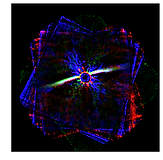Research
Projects
Description of research projects conducted since 2018. See the full paper for more info.
Crotts et al. (2025b)
I reduced and analyzed JWST/NIRCam observations of the TWA 7 debris disk system in the F200W and F444W filters. In these new observations, the disk shows many of the same substructures as observed previously, including three disk components and a southern dust clump. Most excitingly, the planet candidate observed with MIRI (Lagrange et al. 2025) is also observed faintly in the F444W. The NIRCam observations support the candidate being a warm Saturn mass planet rather than a background galaxy or brown dwarf. The candidate is also located in an underdense region of ring 2, where a planet was predicted to reside in Ren et al. (2021). If confirmed, TWA 7b is currently the lowest mass planet to be directly imaged and is only the second planet detected (after Beta Pic b) that was initially predicted based on the debris disk morphology.


Crotts et al. (2024a)
I conducted an empirical analysis of 23 debris disks using multiwavelength GPI observations in polarized intensity. I find that the majority of disks appear perturbed in the form of asymmetries in the disk geometry, surface brightness, and/or disk color. Such asymmetries may be the result of unseen planets in these systems, and also suggest that complex morphologies as seen in scattered light are common. The left figure shows the 23 debris disk observations, rotated, and overlaid with the best fitting ellipse used to derive the disk geometry.

Crotts et al. (2024b)
As mentioned, debris disks can be used as signposts for hidden planets in these systems. N-body simulations can be used to probe the mass and orbit of such planets through replicating the disk morphology via planet-disk interactions. In my most recent project, I used the simulation code REBOUND to constrain the possible mass and orbit of the planet responsible for the complex morphology of the HD 111520 disk. The above figure is a synthetic scattered light observations based on a REBOUND simulation including a 1 Jupiter-mass planet orbiting on an eccentric and inclined orbit of 4 degrees relative to the disk.

Crotts et al. (2022)
I analyzed GPI and HST observations of the extreme HD 111520 debris disk. Through this analysis I confirm a strong brightness asymmetry in the GPI data. Additionally the HST observations reveal a fork-like structure in the NW extension (right side), alongside a 4 degree warp on either side of the disk. These features strongly suggest perturbation from an unseen planet.

Crotts et al. (2021)
I analyzed GPI polarized intensity observations of the HD 106906 debris disk. This system is unique in that it also has a known multi-Jupiter mass planet orbiting outside the disk (HD 106906b). The above figure shows the H-band data (left), our best fitting radiative-transfer model created with the code MCFOST (middle), and the resulting residuals (right). The lingering residuals in the SE (left side) are the result of the disk's asymmetrical nature, where the disk harbours a brightness asymmetry and is likely highly eccentric. These asymmetries can be connected to interactions between the disk and the known planet.

